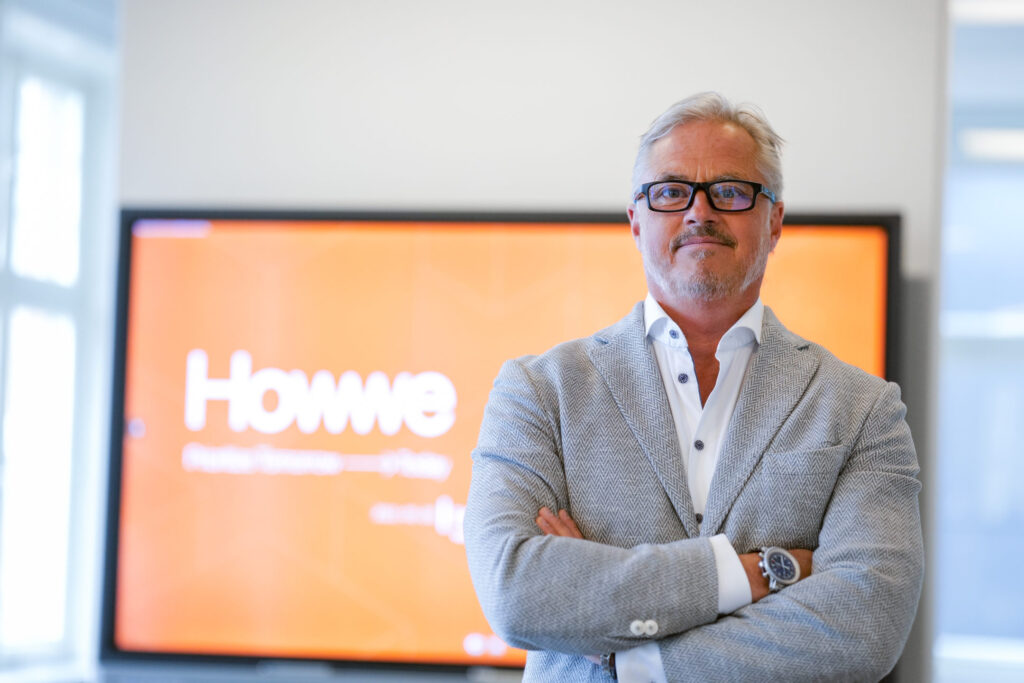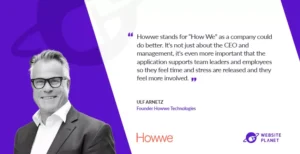Per Forslund is the President of Howwe Technologies, a fast-growing company with high ambitions to change the way companies work. Their software, Howwe, is often referred to as the CEO’s and management’s best friend. In this interview, Per talks about his journey, important drivers for successful leadership, and why he does annual audits with himself.
Leading a smaller organization comes with many advantages
Leading a smaller organization has many advantages, and as with most development companies in a scale-up phase, Per has to wear several hats. Apart from being the President, he is a co-founder and operationally responsible for the company’s activities in the Nordics. He also supports the company in product development, sales, and marketing.
“I’m not the type of person who can be employed. I realized early on that I cannot have a boss. Whether it’s positive or not, I don’t know,” says Per with a laugh. “I want to be involved and make an impact. I like to drive various types of issues that create value, and that’s precisely what my role as President and co-founder is all about.”
Per has been the President of Howwe Technologies for over five years, but he is no stranger to leadership roles.
“There are many similarities between my current role and my previous roles as an operations manager and co-owner. The biggest difference is that those companies were larger than we are currently. In larger organizations, the needs look different. There is often an opportunity to scale down the number of hats and focus more on leadership.”
Per has always had a drive towards leadership roles. One of the significant advantages of leading a smaller company in a scale-up phase, and the broader responsibility that comes with it, is that there are more opportunities to set good examples.
“We have a whole new type of business innovation, and we break new ground every day. It can be challenging, but by being operationally involved in, for example, the sales team, I can show the team that it is possible.”
Strong driving forces with global goals
There is no doubt that Per has strong driving forces that have contributed to his position today. These driving forces are also present in his daily operational work.
“My driving forces are clear. To begin with, it’s about building value. We must constantly be responsive to ensure that what we do creates as much value as possible for our customers.”
Gathering the right talents to make it happen – and having fun while changing the way the world works
One of Per Forslund’s driving forces is to be part of a group of highly professional and competent people.
“We’re doing something that no one else has done, and I’m incredibly grateful to be a part of it. I have talented people around me who all love the challenge we have ahead of us and help each other to succeed.”
Then you have to have fun along the way. Having fun is so important. If I no longer have fun, it’s a clear indication that it’s time to do something else. I’ve been with Howwe Technologies for over ten years, and so far, I’ve enjoyed myself every day.
“My absolute highest driving force is to put Howwe on the world map. It’s not something I do alone; I do it with the people in my company, and it’s cool to succeed together,” says Per.
A leadership mindset
There are as many leadership styles as there are leaders. The leadership style is often a reflection of the leader’s personality and values. Per exudes a sense of security in his way of leading the organization.
“In my opinion, leadership is built on clarity. Then you need to live what you preach. I can’t expect people to be passionate about what they do if I’m not. I am clear in my expectations, give responsibility, and do not micromanage.”
Another aspect that Per believes is important in a good leadership style is to be a good listener. Listening first and then providing input is key, according to Per.
The importance of a strong corporate culture is apparent to Per, as leadership style is closely linked to personality and values. The employees describe the corporate culture as unique. Having fun is one of the strong keywords, and there should be an open and team-oriented atmosphere where people help each other.
“Creating a culture of helpfulness is important. I often talk about being straightforward, and that can be harder. You need to separate the issue from the person. It’s difficult for many people who take things personally. It’s a situation that was wrong, not a person, which is two completely different things. Everyone must realize that they play a role in a larger wheel where they interact with others. Interaction is necessary for us to develop, so it must work.”
However, Per is allergic to people who talk about someone else. If he hears something about himself through someone else, he is not interested. But if someone talks to him directly, he listens and takes it in.
Many business leaders testify that it is lonely at the top, but Per does not recognize himself in that. “We have a very good collaboration within the company. As President, I have to make certain decisions to move us forward. I have no problem with that, and I rarely feel lonely.”
The result of the leadership style can be seen in the employees’ satisfaction. How do you get your employees to develop and perform at their best?
“You have to be passionate about what you are doing. If I am passionate, it rubs off, and it becomes a positive escalation. I am surrounded by passionate and talented people.”
Per’s task as a leader is to create the right conditions for the employees. Then it is up to the individual to show whether they want to take on that responsibility or not.
“I create the right conditions by matching clear goals with the right resources and skills. Then I also give, as far as possible, more responsibility than the person initially thinks they can handle. Employees who have something to grow into develop best.”
A large part of creating the right conditions is about building good teams. Research in this area shows that group dynamics are redefined every time a new employee joins the group. We are a rapidly growing company, so this is a constant ongoing process. If someone comes in where there is friction in the group, it is important to act quickly, says Per.
“I have learned to recruit people with a lot of heart. Having a culture where people can and dare to ask for help facilitates things. I always encourage new hires to demand answers because then they will get into work and the corporate culture faster. If the atmosphere is open, it’s not a problem.”
Per compares a CEO’s success factor with the ability to gather talented people around oneself who have qualities and skills that complement those he himself possesses. The right person in the right place is the key to success.
“Behavior and psychology in an organization are incredibly important. My goal is to get the employees in the company to exceed themselves and find it enjoyable to come to work.”
Personal and Professional Self-Assessment
Companies conduct annual financial reports. Per also conducts a self-assessment, both personally and professionally.
“I ask myself how the year has been, what I could have done better, what I have learned. Have I had fun? If it hasn’t been fun, I ask myself if I can influence it. If I can’t, then I do something else. In this process, it is important for me not to dwell on it. After my self-assessment, I move on. My self-assessments help me navigate my emotions, and that’s why I’ve stayed for 10 years.”
How has the Role of CEOs Changed in the Last Few Years?
We live in a time of rapid change where the challenges of the CEO role look very different today than they did 10 years ago.
As a CEO today, you need to be aware of competitors and trends in a way that you didn’t need to before. With the rapid technological developments, completely new types of competitors can emerge that you haven’t even thought of before.
The normal constellation where everyone goes to work is also completely gone. You have to be able to lead in a flexible environment where employees can be anywhere. This places higher demands on leaders to motivate employees. The traditional office becomes more of a meeting place for creative meetings than a workplace. You have a workplace where you feel like it.
The pandemic has also completely changed the playing field. Where you work from is less important. Previously, with a Stockholm-based headquarters, we had a limited catchment area, but now we can offer the best talent a flexible workplace, wherever they live or prefer to work from.
Another aspect that affects the CEO role is the demands of younger generations. They have completely different demands on the purpose of the work they perform. Having a role and tasks is not enough, says Per.
Howwe is a business platform that helps its customers achieve their goals. Of course, they use the platform themselves.
When we ourselves do not achieve the results we have set, it is extremely frustrating. It is a problem that all leaders struggle with, and research shows that 80% of all companies do not achieve the goals they have set in their strategies. That’s what we’re here to change.
Howwe Technologies is developing and growing rapidly. Where will you be in five years?
In five years, we will be in all major markets in the world. We have revolutionized how companies and their organizations work and set a standard for how to goal-direct their organization to be internationally competitive.





